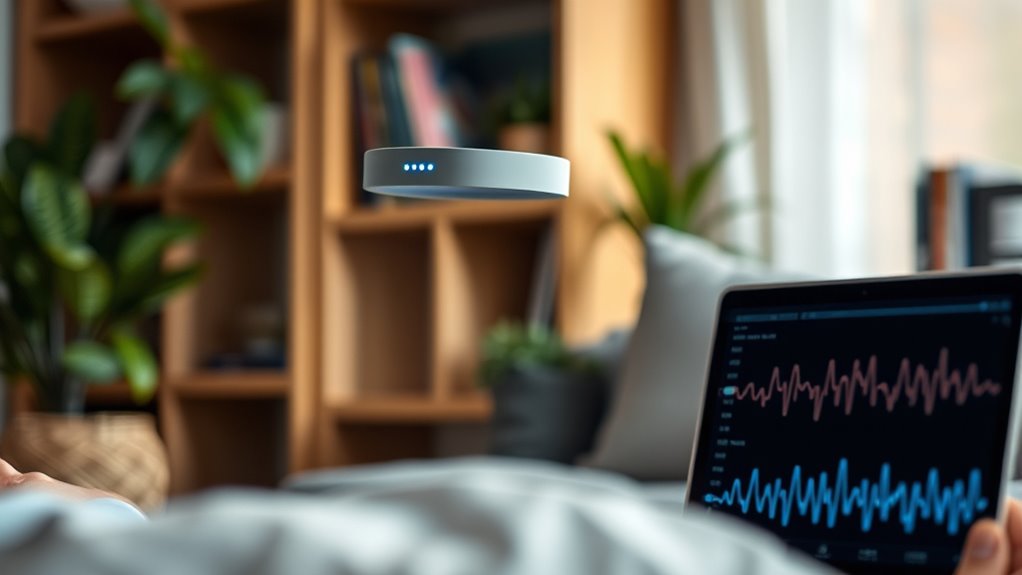Wireless, minimally invasive brain sensors are now designed for comfortable, everyday use at home. These tiny devices sit between your hair and skin, capturing high-quality neural signals without mess or discomfort. They let you control devices, interact with AR environments, or monitor your health with ease. You can wear them for hours during daily activities, making brain-computer interfaces practical and accessible. If you’re interested, you will discover how these innovations are shaping your future interactions with technology.
Key Takeaways
- Microstructure brain sensors are tiny, non-invasive devices placed between hair strands for comfortable, long-term neural monitoring at home.
- These sensors capture high-quality neural signals wirelessly, supporting up to 12 hours of continuous use.
- They enable control of devices and digital environments through brain signals, suitable for activities like AR calls and smart home management.
- Advanced microfabrication and neural sensing technology improve signal clarity and responsiveness for at-home applications.
- Ideal for neurofeedback, health monitoring, and assistive device control, offering a painless alternative to traditional brain-computer interfaces.

Advancements in brain-computer interface (BCI) technology now make it possible to control devices and monitor neural activity from the comfort of your home. Imagine wearing a tiny, almost invisible sensor that sits comfortably between your hair follicles and just under the skin. Developed by Georgia Tech, this microstructure brain sensor is designed for everyday use, providing a non-invasive way to capture high-quality neural signals. Unlike traditional gel-based electrodes, which can be messy and uncomfortable, this sensor fits seamlessly into your hair, avoiding the limitations of bulky equipment. Its placement in small spaces between hair strands ensures you experience maximum comfort, making long-term monitoring feasible without irritation or inconvenience.
This tiny sensor doesn’t just sit passively; it actively captures neural signals with a fidelity comparable to invasive methods, yet it remains painless and non-invasive. Thanks to wireless integration, you can move freely—standing, walking, or even running—without losing stable, accurate brain signal detection. The design allows continuous neural monitoring for up to 12 hours, so you can go about your day without interruptions or signal degradation. Its low electrical resistance at skin contact points ensures consistent, reliable data collection, enabling precise interpretation of your neural activity. This innovation is made possible by advances in microfabrication and neural sensing technology. Additionally, the development of high-resolution neural sensors has been crucial in improving signal clarity and device responsiveness.
With this technology, you can control devices and interact with digital environments effortlessly. For example, neural signals can classify your focus on visual stimuli with an accuracy of 96.4%, enabling you to initiate or accept AR video calls hands-free. You could also communicate with your smart home system using just your thoughts, adjusting lighting, temperature, or appliances without lifting a finger. The robustness of the sensor allows for uninterrupted use even during physical activity, giving you real-time control in dynamic environments.
Non-invasive BCIs like this utilize brain electrical activity to establish a direct communication pathway between your mind and external devices, bypassing muscles entirely. The micro-needle technology embedded in the sensor enhances signal resolution by accessing skin beneath hair, providing clearer data than traditional scalp electrodes. The system’s architecture—covering signal acquisition, feature extraction, translation, and device output—ensures efficient and accurate control of connected devices. Wireless data transmission further streamlines the process, facilitating seamless interactions from your home.
The potential applications are vast. You could manage AR entertainment, monitor your cognitive or emotional states for personalized health insights, or automate your home environment through thought commands. For individuals with motor impairments, these sensors open doors to greater independence, allowing control of assistive devices effortlessly. Neurofeedback therapies for anxiety, depression, or ADHD become more accessible at home, giving you tools to improve mental health without frequent clinic visits. Compared to traditional BCI methods, this technology offers a painless, minimally intrusive experience that eliminates discomfort and variability caused by gels or scalp electrodes, bringing brain-controlled technology directly to your everyday life.
Frequently Asked Questions
Are Home BCI Devices Safe for Long-Term Use?
You might wonder if home BCI devices are safe for long-term use. Current evidence shows that implanted BCI systems have a good safety profile, with no serious adverse events over a year. Wearable devices are designed for ease and safety, but long-term data is limited. Regular monitoring, proper training, and device design improvements help minimize risks, making them a promising option, though ongoing research is essential to confirm extended safety.
How Accurate Are Wearable BCIS in Daily Life?
In daily life, wearable BCIs deliver accuracy ranging from 70% to 90%, depending on how well the signals are processed and the device’s design. You benefit from improved sensors that capture high-quality signals during everyday activities, even with minimal discomfort. Whether you’re monitoring stress or controlling devices, these BCIs maintain consistent performance, allowing you to use them confidently across different environments, tasks, and routines.
Can BCIS Help With Mental Health Issues at Home?
You wonder if BCIs can help with mental health issues at home. They can. Wearable BCIs analyze your brain activity to diagnose and monitor conditions like depression, anxiety, or PTSD. They also provide neurofeedback, helping you learn self-regulation, reduce symptoms, and improve emotional control. Plus, BCIs enable communication and cognitive support, making mental health management more accessible, personalized, and effective right from your home.
What Are the Privacy Concerns With At-Home BCIS?
You’re concerned about privacy with at-home BCIs because they collect your most personal thoughts, emotions, and memories. If hackers access your device, they could manipulate or misuse your neural data, leading to privacy violations or exploitation. Without strict security and clear consent, your mental privacy is at risk. It’s vital to guarantee your data is protected, and you understand how your neural information is used and shared.
How Affordable Are Consumer-Grade Brain-Computer Interfaces?
You might wonder how affordable consumer-grade BCIs are. Currently, these devices are still somewhat costly due to advanced sensors and hardware, limiting widespread adoption, especially in developing regions. However, startups and companies are working to lower prices by using cheaper materials and open-source designs. As production scales up and investments grow, expect prices to decrease, making wearable BCIs more accessible for everyday use, gaming, and health applications.
Conclusion
So, now that you can wear brain-computer interfaces at home, who needs friends or hobbies? Just strap on that device, and suddenly you’re the master of your own mind—until it inevitably misfires during that vital Zoom call. But hey, at least you’ll look super futuristic while trying to remember if you actually remembered to plug it in. Welcome to the future, where your brain’s just another gadget waiting to be hacked!










